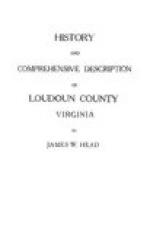DERIVATION OF NAME.
Loudoun County was named in honor of Lord Loudoun, a representative peer of Scotland, who, the year before its establishment, and during the French and Indian war, had been appointed captain-general and governor-in-chief of the province of Virginia, and commander-in-chief of the British military forces in the Colonies.
His military avocations, however, prevented him from entering upon the duties of the gubernatorial office, and it is believed that he never visited the colony of Virginia. Dinwiddie continued in the control of its affairs, while Loudoun turned his attention to military matters, in which his indolence, indecision, and general inefficiency were most conspicuous and disastrous. Franklin said of him: “He is like little St. George on the sign-boards; always on horseback, but never goes forward.”
Until his early recall to England, contemporaneous writers and brother officers mercilessly criticised Loudoun “whom a child might outwit, or terrify with a pop-gun.”
Hardesty’s Historical and Geographical Encyclopedia contains the following succinct account of the public services rendered by this noted Scotchman:
“John Campbell, son of Hugh, Earl of Loudoun, was born in 1705, and succeeded his father in the title in November, 1731. In July, 1756, he arrived in New York with the appointment of governor-in-chief of Virginia, and also with the commission of commander-in-chief of the British forces in America, but, proving inefficient, returned to England in 1757. He was made Lieutenant-General in 1758, and General in 1770. He died April 27, 1782, and was succeeded by Norborne Berkeley, Baron de Botetourt, as governor of Virginia, in 1768.”
SETTLEMENT AND PERSONNEL.
The permanent settlement of Loudoun began between the years 1725 and 1730 while the County was yet a part of Prince William and the property of Lord Fairfax, the immigrants securing ninety-nine-year leases on the land at the rate of two shillings sterling per 100 acres. The above-noted interim saw a steady influx of the fine old English Cavalier[18] stock, the settlers occupying large tracts of land in the eastern and southern portions of the County or most of the territory extending from the Potomac River southward to Middleburg and from the Catoctin and Bull Run mountains eastward to the eastern border of the County. It is more to this noble and chivalric strain than to any other that Loudoun owes her present unrivalled social eminence.




